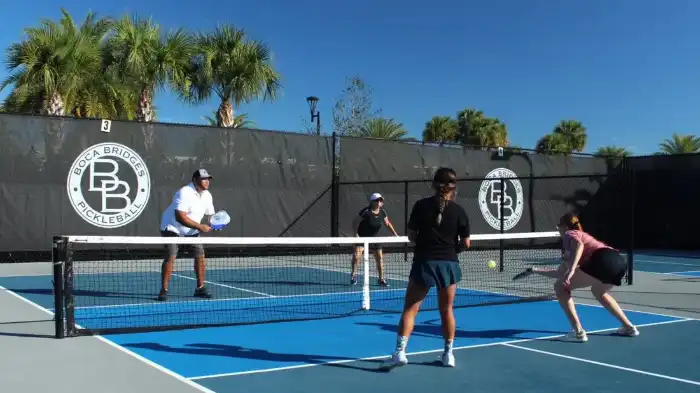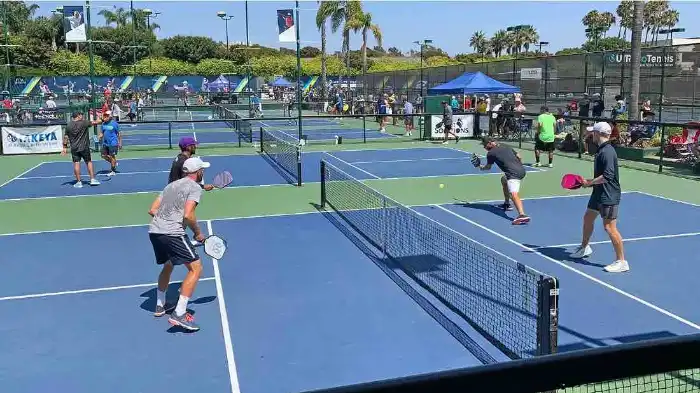“Can the Ball Bounce in the Non-Volley Zone on a Serve in Pickleball?” This question delves into the nuanced rules surrounding the non-volley zone, a critical element in pickleball designed to maintain fairness and strategic play near the net. Understanding the non-volley zone regulations is essential for players seeking to master the game.
In this blog post, we are going to discuss the rules for the non-volley zone in pickleball, purpose of the Non volley zone pickleball rules, serve exceptions in the non-volley zone, and whether the ball bounces in the non-volley zone on a serve in pickleball.
Rules for Non Volley Zone Pickleball
The non-volley zone plays a crucial role in pickleball and is aimed at preventing players from executing powerful shots close to the net. According to the rules, players cannot make a volley (a shot made without allowing the ball to bounce) while standing within the non-volley zone. This restriction applies to both serves and regular play. However, there is an exception for serves that allows players to stand within the non-volley zone while still volleying the ball.

Purpose of the Non-Volley Zone Rule
The non-volley zone rule in pickleball aims to facilitate fair play and prevent players from dominating the game near the net. By forcing players to allow the ball to bounce before they can make a volley while within the non-volley zone, it levels the playing field and encourages strategic placement of shots.
Avoiding the Dominance of Volley Shots
If the rule did not exist, players would have the option to stand within the non-volley zone and execute powerful volleys, making it difficult for their opponents to respond. This would disperse the gameplay unevenly and eliminate the need for players to exhibit skill in shot selection and placement. The non-volley zone rule helps to maintain balance and encourages rallies by giving players an opportunity to react and strategize.
Serve Exceptions in the Non-Volley Zone
During the serve, the player has two options: they can either hit the ball before it bounces or let it bounce once before striking it. When the serve is performed, the server must be behind the baseline, from which the ball must clear the middle of the non-volley zone and land within the opponent’s diagonal service court. To execute this serve legally, the server can stand within the non-volley zone, as long as they do not volley the ball while standing within it.
If the server decides to let the ball bounce once before hitting it, they have the advantage of increasing their margin for error. This means that even if the ball bounces in the non-volley zone, the serve is still considered valid, as long as the server is behind the baseline at the time of contact. However, should the server hit the ball before it bounces inside the non-volley zone, it would result in a fault.
Can the Ball Bounce in the Non-volley Zone on a Serve in Pickleball?
Yes, the ball can bounce in the Non-Volley Zone (NVZ) on a serve in pickleball. During the serve, the server has the option to either hit the ball before it bounces or let it bounce once before striking it. If the server chooses to let the ball bounce, it can bounce in the NVZ, but the key is that the server must be behind the baseline when making contact with the ball.

This bounce option provides the server with an increased margin for error, allowing for a valid serve even if the ball bounces in the NVZ, as long as all other serving rules are followed. However, if the server hits the ball before it bounces inside the NVZ, it would result in a fault.
Conclusion
In conclusion, understanding the rules surrounding the Non-Volley Zone (NVZ) in pickleball is essential for players looking to elevate their game. The NVZ, designed to promote fair play near the net, prohibits volleys within its boundaries, except for specific serve exceptions. The purpose of this rule is clear—to prevent the dominance of powerful shots close to the net and encourage strategic and skillful play.
During the serve, players have the option to let the ball bounce once in the NVZ, providing a margin for error. So, to answer the question, “Can the Ball Bounce in the Non-Volley Zone on a Serve in Pickleball?”—yes, it can, as long as players adhere to the designated rules, maintaining the integrity and balance of this exciting racquet sport.
Frequently Asked Questions
If the serve bounces in the non-volley zone and then goes out of bounds or is not successfully returned by the receiving team, it is considered a fault. This means that the serving team loses their serve, resulting in a side-out and giving the opposing team the opportunity to serve.
Yes, after serving, you are allowed to enter the non-volley zone (NVZ). However, you must ensure that the ball has cleared the NVZ before stepping into it. If the ball hasn’t bounced in the NVZ and you step into it before hitting the ball, it will result in a fault.
Yes, there are exceptions to this rule. If the ball touches any part of the non-volley zone, including the lines, before bouncing outside of it, it is still considered a fault. Additionally, if the server’s foot touches the non-volley zone during the serve, it will also result in a fault, regardless of where the ball bounces.
No, the receiving team cannot volley the ball if it bounces in the non-volley zone on a serve. The non-volley zone is a designated area close to the net where players are not allowed to hit the ball in the air. Therefore, if the serve bounces in the non-volley zone, the receiving team must wait for it to bounce again before hitting it, as per the rules of pickleball.
Yes, during a serve in pickleball, the ball can bounce in the Non-Volley Zone (NVZ). Players have the option to let the ball bounce once before striking it, provided they are behind the baseline when making contact.

